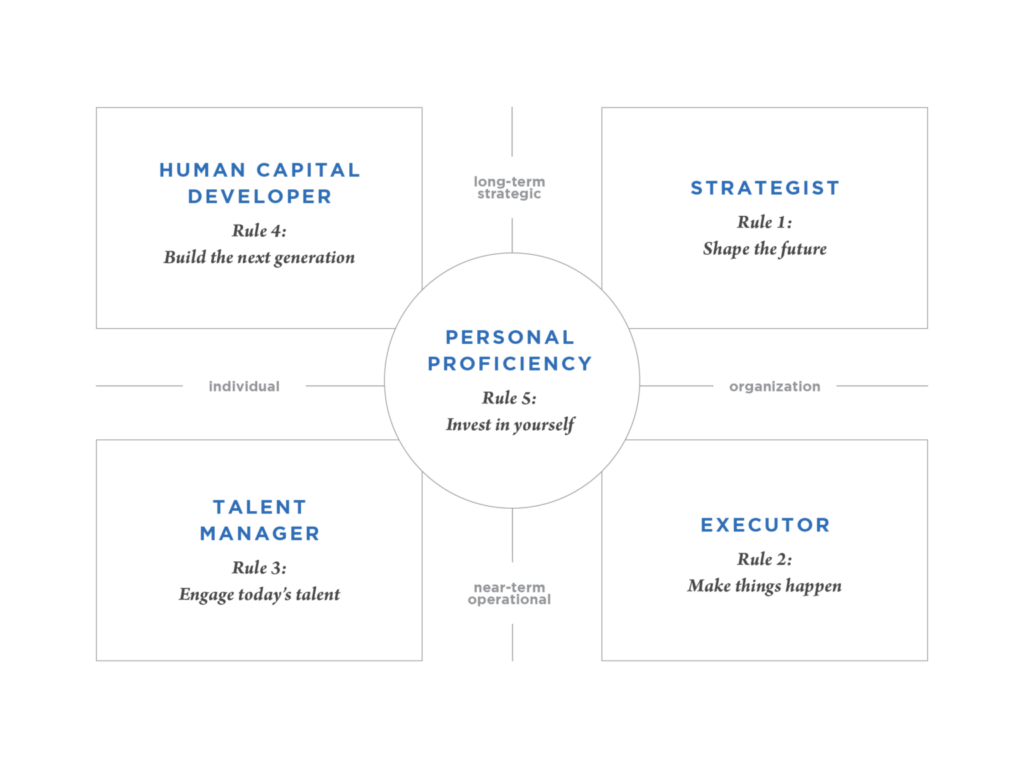The belief beneath the cliché “leadership is leadership” is that leadership is a transferable skill—that what it takes for someone to be effective as a leader in one field can be transferred to a different field. In the book, The Leadership Code, Dave Ulrich articulates that as much as 70% of leadership is transferable. Meaning if someone is a great high school volleyball coach, then the person has 70% of what it takes to be a great leader of a division in a company, and 30% is “domain specific to the industry” that must be learned. The Leadership Code framework distills the 70% down to five essential roles:

What I Appreciate About This Framework
- The emphasis on integrity: With personal proficiency or integrity at the center, this framework emphasizes that it does not matter how skilled you are at leading others if you are not able to lead yourself.
- The exhortation to develop in all areas: Of execution, strategy, talent managing, and being a human capital developer, Ulrich says that all of us have a “towering strength,” but that the more we progress in our leadership, the better we must be at all four. If we ignore our weaknesses, they can become debilitating deficiencies that overpower our strengths.
- The reminder to be ambidextrous: The framework emphasizes that leaders need to care for both the organization and the individual and think about today and the future. Yes, this is massively challenging but equally important.
How This Framework Has Helped Me
I have used this framework when I’m invited to speak to marketplace leaders. In those settings I have asked business leaders to force-rank themselves on the four roles/tasks—and overwhelmingly, “human capital developer” is the lowest. I once spoke to a group of 70 CEOs and not one of them claimed that their towering strength was to develop others. I reached out to Dave Ulrich, who was very kind and gracious to respond, and he shared how in all his research “human capital developer” is the one leaders struggle with the most. The pressures of today, the inbox, and the emergencies can pull leaders away from developing others.
Because of those conversations and experiences, I have learned to find ways to put time in my calendar and plans in my regular rhythms of leading for all four leadership domains. I benefit from large blocks of time for strategic thinking, clear goals and self-imposed deadlines for execution, and plans for how I will invest in future leaders.
How to Use This Framework
This framework is a great tool to evaluate your own leadership. Identify your towering strength as well as areas that could be debilitating weaknesses. For those potential weaknesses, put safeguards around yourself to help you. If you struggle with strategy, find some strategic thinkers to spend more time with. If you struggle with execution, submit yourself to goals and deadlines. If you are neglecting being a human capital developer in your leadership, build some rhythms into your life that put you with emerging leaders frequently. And then you can also coach your team to do the same.
This framework is also a helpful tool to guide important conversations with your team. For example, I will sometimes use language from this framework in meetings with some of my leaders to set up part of a meeting. “I want us all to put on our execution hats for this discussion,” or “I want us to think further out and wear our strategic hats for this conversation.”
You can download the PDF for this leadership framework here.






